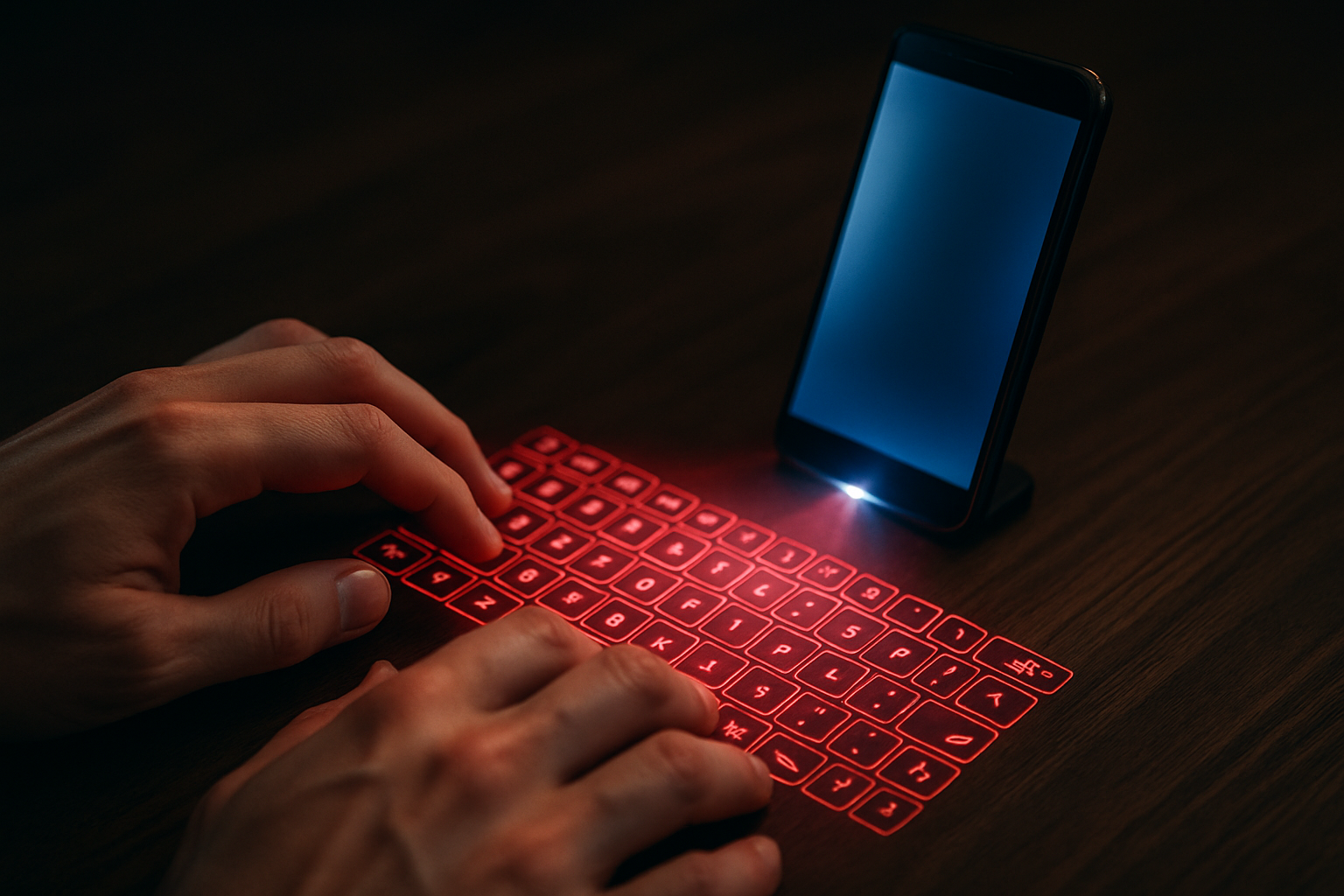Holographic Keyboards: The Next Frontier in Mobile Typing
In an era where our smartphones are becoming increasingly powerful and versatile, one aspect has remained stubbornly unchanged: the virtual keyboard. But what if we could type on thin air, with a holographic keyboard projected from our devices? This futuristic concept is rapidly becoming a reality, promising to revolutionize how we interact with our mobile devices.

The Science Behind Holographic Keyboards
At the heart of holographic keyboard technology lies a clever combination of optics and sensor systems. A tiny projector emits a laser-generated image of a keyboard onto a flat surface. Simultaneously, an infrared light plane is projected just above the virtual keys. When a user’s fingers break this light plane, cameras or sensors detect the movement and translate it into keystrokes.
This technology relies on sophisticated algorithms that can distinguish between intentional key presses and accidental movements. The system must also account for variations in typing styles and environmental conditions, ensuring accurate input across different scenarios.
The Evolution of Virtual Input
Holographic keyboards aren’t an overnight invention but rather the culmination of years of research and development in virtual input methods. Early attempts at projection keyboards date back to the early 2000s, with companies like Canesta and VKB introducing rudimentary versions of the technology.
These initial offerings faced numerous challenges, including poor accuracy, high power consumption, and limited compatibility with existing devices. However, they laid the groundwork for the more advanced systems we’re seeing today, demonstrating the potential for typing without physical keys.
Current State of the Technology
While holographic keyboards are not yet ubiquitous, several companies are making significant strides in bringing this technology to market. Celluon, a South Korean firm, has been at the forefront with its Epic line of laser projection keyboards. These devices can connect to smartphones and tablets via Bluetooth, offering a glimpse into a future where our mobile devices can create full-sized keyboards on demand.
Other players in the space include Serafim with its Keybo device, which combines a projector and power bank, and Brookstone’s Virtual Keyboard, which can be used with computers and mobile devices alike. These products typically range in price from $100 to $200, positioning them as premium accessories for tech enthusiasts and early adopters.
Advantages and Potential Applications
The appeal of holographic keyboards extends beyond their futuristic allure. These devices offer several practical advantages over traditional physical and on-screen keyboards:
-
Portability: Holographic keyboards eliminate the need to carry bulky physical keyboards, making them ideal for travelers and mobile professionals.
-
Hygiene: With no physical surface to harbor germs, holographic keyboards could be particularly beneficial in shared or public environments.
-
Customization: The projected layout can be easily customized to different languages or specialized input needs, offering unparalleled flexibility.
-
Ergonomics: Users can position the virtual keyboard at the most comfortable height and angle, potentially reducing strain associated with prolonged typing.
Beyond personal computing, holographic keyboards could find applications in various fields. In healthcare, they could provide a sterile input method in clinical settings. For education, they could offer an engaging way to teach typing skills. In public spaces, they could serve as temporary kiosks or information terminals without the need for physical installations.
Challenges and Limitations
Despite their potential, holographic keyboards face several hurdles on the path to widespread adoption:
-
Tactile Feedback: The lack of physical keys means users don’t receive the tactile feedback they’re accustomed to, which can lead to slower typing speeds and increased errors.
-
Surface Dependence: Current holographic keyboards require a flat, opaque surface to function properly, limiting their usability in some environments.
-
Lighting Conditions: Bright ambient light can interfere with the projection, potentially rendering the keyboard unusable in outdoor settings.
-
Battery Life: The power requirements for projection and sensing technologies can strain mobile device batteries.
-
Cost: Current holographic keyboard solutions are significantly more expensive than traditional alternatives, limiting their mass-market appeal.
The Road Ahead
As holographic keyboard technology continues to evolve, we can expect to see improvements that address many of these limitations. Research is already underway to incorporate haptic feedback systems that could simulate the feel of physical keys. Advanced machine learning algorithms could further improve accuracy and adaptability to different typing styles and environments.
The integration of holographic keyboards directly into smartphones and tablets is another exciting possibility. Companies like Apple and Samsung have filed patents related to built-in projection technologies, hinting at a future where every mobile device could come equipped with a holographic keyboard.
Conclusion: A Glimpse into the Future of Typing
Holographic keyboards represent a fascinating intersection of optics, sensor technology, and user interface design. While they’re not yet ready to replace our physical and touchscreen keyboards entirely, they offer a tantalizing glimpse into the future of mobile computing.
As the technology matures and becomes more affordable, we may find ourselves regularly typing on beams of light, turning any surface into a potential workstation. The journey from science fiction to reality is well underway, and holographic keyboards are poised to play a significant role in shaping how we interact with our devices in the years to come.





